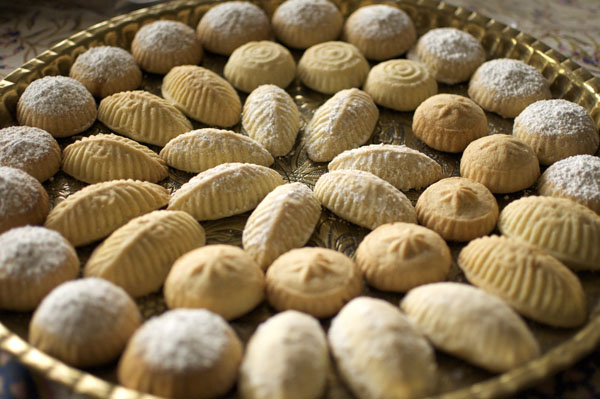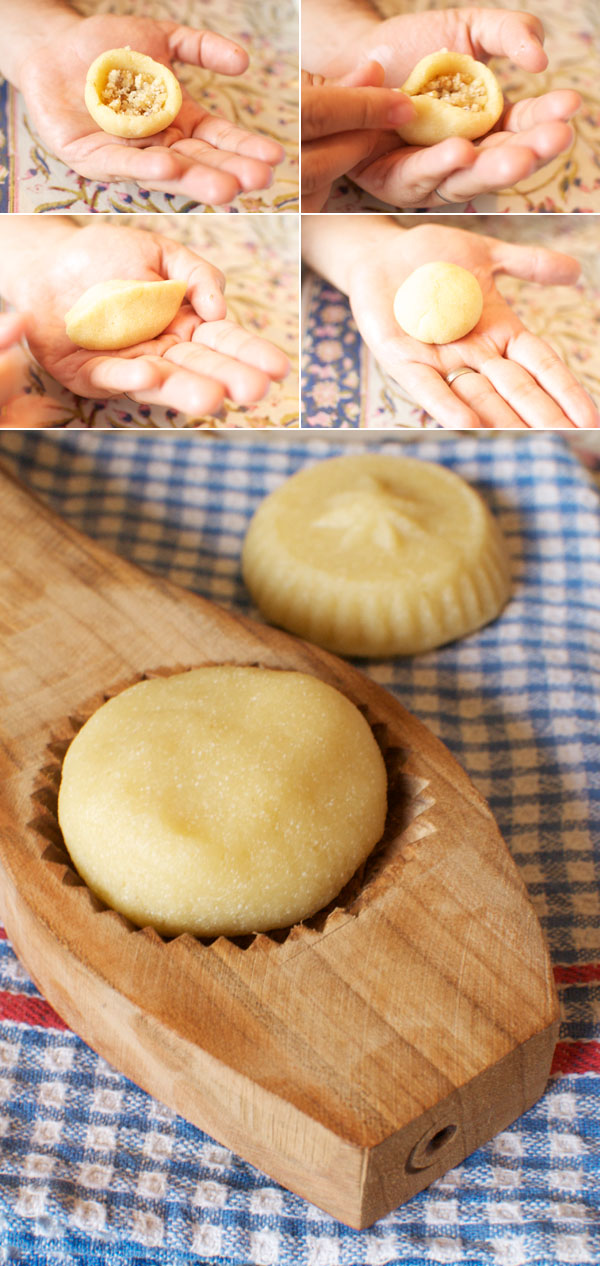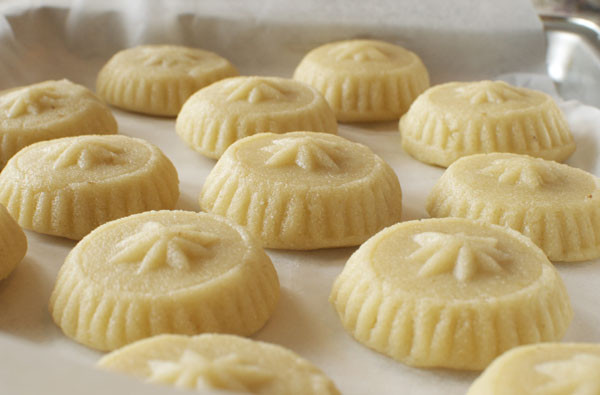
Happy Easter! It’s really great to be able to share this recipe with you, and maybe from the photo above, you too will feel there are things worth coming back to this world for. This is my tray of maamoul, a traditional Lebanese sweet that is made especially for Easter. Maamoul is a semolina shortbread bound with butter, orange blossom water and rose water which on the inside holds a sweet filling. The filling is either buttery dates, or a concoction of walnuts or pistachios with sugar, more orange blossom water and rosewater. Now consider that for a minute. Imagine biting through that buttery, crumbly crust and getting the faint hint of roses and orange blossoms, followed by the chewiness of pistachios, nutty and sweet. Delicious opulence and comfortable luxury. Maamoul works on so many levels.

If you look through the photo series, you will get a basic understanding of how these Easter cakes are made. You can see the beautiful pattern that is formed when the filled dough is pressed into a traditional wooden mold. There is a shape for every flavour and that makes it easy to know which is which. According to Ludwig’s sister, who’s a real wiz with computers, there’s anecdotal evidence pointing to the tradition of making maamoul on Easter. Apparently the wooden mold symbolises Jesus’ cross, the mold’s pattern resembles the shape of the sponge with which Jesus was given vinegar to drink, the crust contains no sugar in reference to Christ’s death containing no happiness, and the inside is sweet and joyful to symbolise the resurrection. I’m not sure how steeped in tradition all this symbolism is, but at the least, it’s a nice story.

It’s been nine years since I’ve taken part in a maamoul making session, and this is actually my first attempt at it, as it was usually my mother who took care of the whole mission. Long distance phone calls with mom, mirrored by similar efforts from Ludwig resulted in the recipe we used. Just like we used to do, the dough was prepared on Good Friday and the maamoul was baked on Easter Saturday. But unlike being under the strict, observing eyes of our parents, this time we allowed ourselves to indulge in trying the maamoul as it was warm, instead of having to wait for Sunday as tradition requires. I am now convinced that eating maamoul warm is the only way to do it with the filling still gooey and slightly runny. The flavour warms my heart and the scent takes me back to my childhood, and the result is a maamoul I know even mom would be proud of!

Maamoul Recipe
Ingredients – Crust
- 900 g coarse semolina
- 150 g fine semolina
- 550 g good quality butter at room temperature
- 125 ml rosewater
- 30 ml orange blossom water
- 1/2 cup milk (used on the second day)
- Equipment – maamoul molds bought from a Middle Eastern supply store
Ingredients – Fillings
Fillings are tricky to give amounts with, because it depends on how many types you want to make. Use these ratios as a guideline, and make less/more depending on how much you want to make- 2 cups dates and 1/2 cup butter combined in food processor
- 2 cups coarsely ground walnuts and 1/2 cup sugar with 2 tbsp rosewater and 1/2 tsp orange blossom water
- 2 cups coarsely ground pistachios and 1/2 cup sugar with 2 tbsp rosewater and 1/2 tsp orange blossom water
- Try the combinations and adjust the sugar and aromatic waters as you like
Method
- Knead the coarse and fine semolina with the butter until incorporated
- Gradually add the orange blossom water and the rosewater until all added
- Knead for 30 minutes
- Rest for 12 hours, kneading it around 3 times in between
- Before you start using the dough, you must knead it one last time, this time you wet your hands with the 1/2 cup of milk and kneading until all the milk is used up
- Now your dough is ready, create a little ball of dough and make a hole in it, making the sides even
- Look at the picture that shows the stages of filling the maamoul. Fill with your desired filling. If you are using dates, they should be formed into individual balls to fill the dough
- Close the dough so that the filling is totally covered by dough
- Put in the maamoul mold and push firmly but not overly so, otherwise the dough will stick
- Put a cutting board and cover with a kitchen towel
- Strike the top tip of the mold on the kitchen towel to release the maamoul
- Repeat and when you have a tray full, put into an oven that has been preheated to 220 degrees Celsius
- It will take around 15 minutes to bake, but what you are after is the slightest colouring. You don’t want it to brown
- Remove, cool down and eat when warm or cold












